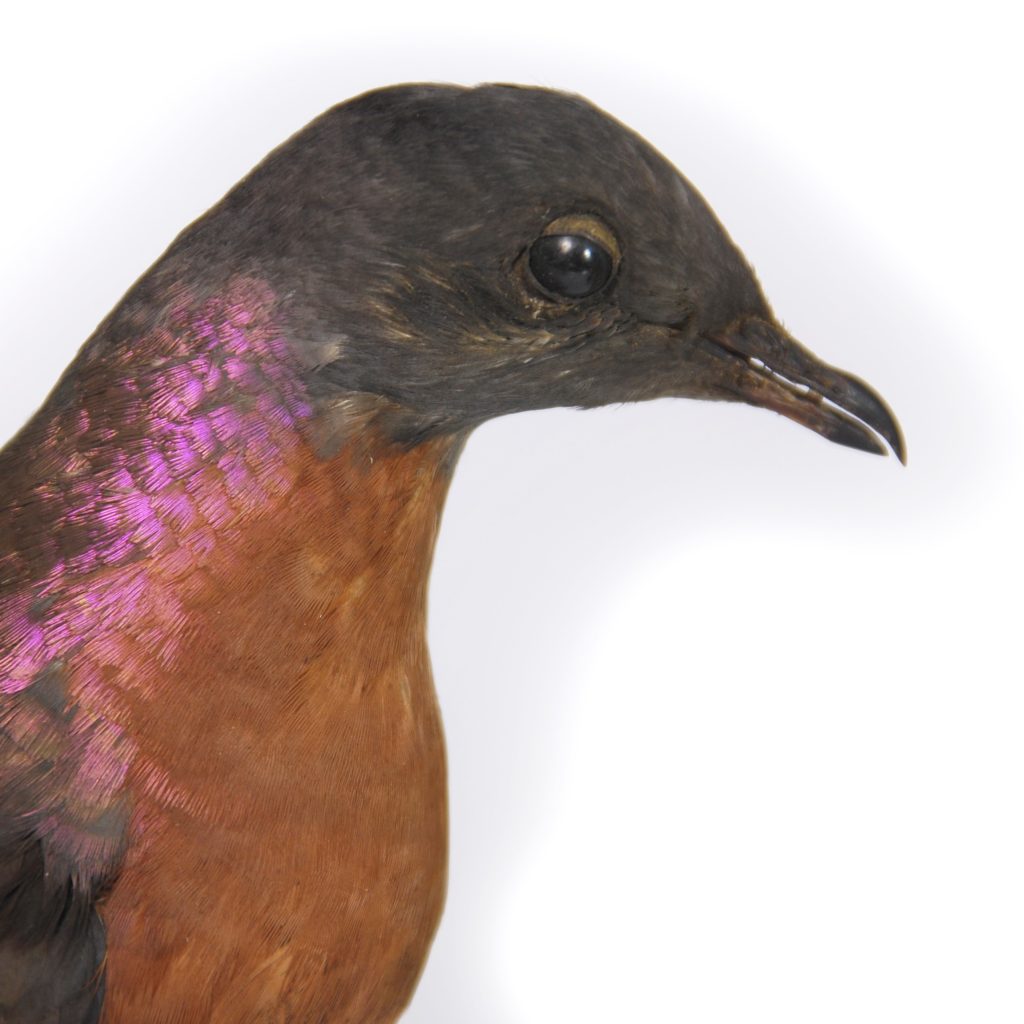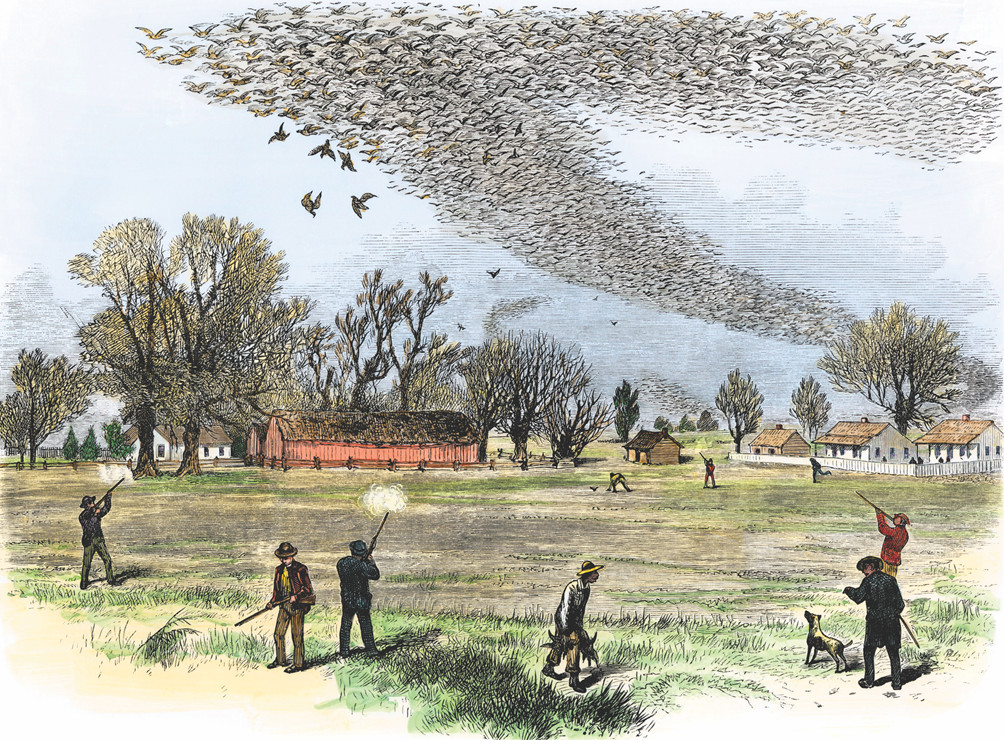The Bath Royal Literary and Scientific Institution Collection includes two taxidermy mounts of the Passenger Pigeon (Ectopistes migratorius). Once the most numerous bird in the world, this species became extinct in 1914, a victim of overhunting.
John James Audubon, the eminent American naturalist and bird artist, observed the drama of a dense mass of passenger pigeons passing overhead. Here we reproduce a portion of his account:
In the autumn of 1813, I left my house at Henderson, on the banks of the Ohio, on my way to Louisville. I observed the pigeons flying from north-east to south-west, in greater numbers than I thought I had ever seen them before, and feeling an inclination to count the flocks that might pass within the reach of my eye in one hour.
I dismounted, seated myself on an eminence, and began to mark with my pencil, making a dot for every flock that passed. In a short time finding the task which I had undertaken impracticable, as the birds poured in in countless multitudes, I rose, and counting the dots then put down, found that 163 had been made in twenty-one minutes. I travelled on, and still met more the farther I proceeded. The air was literally filled with Pigeons; the light of noon-day was obscured as by an eclipse; the dung fell in spots, not unlike melting flakes of snow; and the continued buzz of wings had a tendency to lull my senses to repose.
Before sunset I reached Louisville, distant from Hardensburgh fifty-five miles. The Pigeons were still passing in undiminished numbers, and continued to do so for three days in succession. The people were all in arms. The banks of the Ohio were crowded with men and boys, incessantly shooting at the pilgrims, which there flew lower as they passed the river. Multitudes were thus destroyed. For a week or more, the population fed on no other flesh than that of Pigeons, and talked of nothing but Pigeons. The atmosphere, during this time, was strongly impregnated with the peculiar odour which emanates from the species.
As soon as the Pigeons discover a sufficiency of food to entice them to alight, they fly round in circles, reviewing the country below. During their evolutions, on such occasions, the dense mass which they form exhibits a beautiful appearance, as it changes its direction, now displaying a glistening sheet of azure, when the backs of the birds come simultaneously into view, and anon, suddenly presenting a mass of rich deep purple. They then pass lower, over the woods, and for a moment are lost among the foliage, but again emerge, and are seen gliding aloft. They now alight, but the next moment, as if suddenly alarmed, they take to wing, producing by the flappings of their wings a noise like the roar of distant thunder, and sweep through the forests to see if danger is near. Hunger, however, soon brings them to the ground.
When the woods are filled with these Pigeons, they are killed in immense numbers, although no apparent diminution ensues. A great number of persons, with horses and wagons, guns and ammunition, had already established encampments on the borders. Two farmers from the vicinity Russelsville, distant more than a hundred miles, had driven upwards of three hundred hogs to be fattened on Pigeons that were to be slaughtered. Here and there the people employed in plucking and salting what had already been procured, were seen sitting in the midst of large piles of these birds.
As the period of their arrival approached, their foes anxiously prepared to receive them. Some were furnished with iron pots containing brimstone, others with torches of pine-knots, many with poles, and the rest with guns.Suddenly there burst forth a general cry of “Here they come!” The noise which they made, though yet distant, reminded me of a hard gale at sea passing through the rigging of a close roofed vessel. As the birds arrived and passed over me, I felt a current of air that surprised me. Thousands were soon knocked down by the pole-men. The birds continued to pour in. The fires were lighted, and a magnificent as well as wonderful, and almost terrifying sight presented itself.
The Pigeons, arriving in thousands, alighted everywhere, one above another, until solid masses as large as hogsheads were formed on the branches all around. Here and there the perches gave way under their weight, with a crash and falling to the ground, destroyed hundreds of the birds beneath, forcing down the dense groups with which every stick was loaded. It was a scene of uproar and confusion. I found it quite useless to speak, or even to shout to those persons who were nearest to me. Even the reports of the guns were seldom heard, and I was aware of the firing only by seeing the shooters reloading.
The Pigeons were constantly coming, and it was past midnight before I perceived a decrease in the number of those that arrived. The uproar continued during the whole night. Towards the approach of day the noise in some measure subsided; and long before the objects were distinguishable, the Pigeons began to move off in a direction quite different from that in which they had arrived the evening before, and at sunrise all that were able to fly had disappeared.
It was then that the authors of all this devastation began their entry among the dead, the dying, and the mangled. The Pigeons were picked up, and piled in heaps, until each had as many as he could possibly dispose of; then the hogs were let loose to feed on the remainder.


